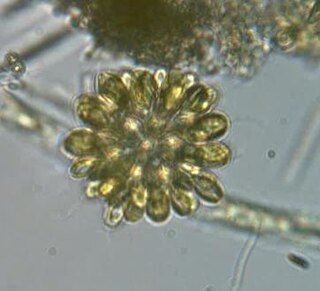
The synurids are a small group of heterokont algae, found mostly in freshwater environments, characterized by cells covered in silica scales.

Brown algae are a large group of multicellular algae comprising the class Phaeophyceae. They include many seaweeds located in colder waters of the Northern Hemisphere. Brown algae are the major seaweeds of the temperate and polar regions. Many brown algae, such as members of the order Fucales, commonly grow along rocky seashores. Most brown algae live in marine environments, where they play an important role both as food and as a potential habitat. For instance, Macrocystis, a kelp of the order Laminariales, may reach 60 m (200 ft) in length and forms prominent underwater kelp forests that contain a high level of biodiversity. Another example is Sargassum, which creates unique floating mats of seaweed in the tropical waters of the Sargasso Sea that serve as the habitats for many species. Some members of the class, such as kelps, are used by humans as food.
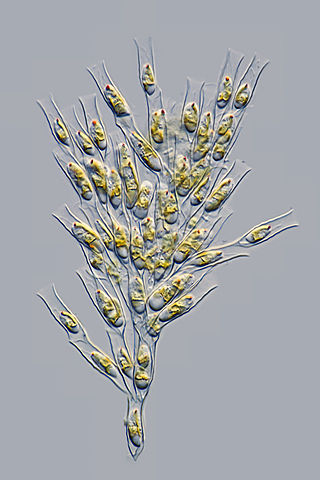
The Chrysophyceae, usually called chrysophytes, chrysomonads, golden-brown algae or golden algae, are a large group of algae, found mostly in freshwater. Golden algae is also commonly used to refer to a single species, Prymnesium parvum, which causes fish kills.
In biology, setae are any of a number of different bristle- or hair-like structures on living organisms.

The Chamaemyiidae are a small family of acalyptrate flies with less than 200 species described worldwide. The larvae of these small flies are active and predatory and are often used for biological control of aphids, scale insects, and similar pests. Chamaemyiid fossils are poorly represented in amber deposits, but a few examples are known from the Eocene epoch onwards.
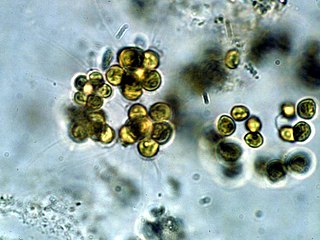
Micractinium is a genus of green algae in the family Chlorellaceae. Species of the genus Micractinium are common in freshwater habitats. A few species are found as endosymbionts of protozoa, such as Micractinium conductrix and Micractinium tetrahymenae.

Althenia is a genus of aquatic plants of the family Potamogetonaceae. This has long been a group of two species in the Mediterranean Europe and South Africa, but in 2016 was revised to include an Australasian relative, Lepilaena. The genus is named after the agronomist Jean Althen.

Ornithocercus is a genus of planktonic dinoflagellate that is known for its complex morphology that features considerable lists growing from its thecal plates, giving an attractive appearance. Discovered in 1883, this genus has a small number of species currently categorized but is widespread in tropical and sub-tropical oceans. The genus is marked by exosymbiotic bacteria gardens under its lists, the inter-organismal dynamics of which are a current field of research. As they reside only in warm water, the genus has been used as a proxy for climate change and has potential to be an indicator species for environmental change if found in novel environments.

Chaetotaxy is the arrangement of bristles (macrochaetae) on an arthropod or annelid, or taxonomy based on their position and size. For example, it is important in Diptera, in which group it was formalised by Ernst August Girschner. The term chaetotaxy was later proposed by Carl Robert Osten-Sacken.

Pollicipes polymerus, commonly known as the gooseneck barnacle or leaf barnacle, is a species of stalked barnacle. It is found, often in great numbers, on rocky shores on the Pacific coasts of North America.
Mallomonas hexareticulata is a species of heterokont algae. It is a tiny free-living cell, about the width of a human hair. It has ornate scales and bristles, as well as long spines. It is a relatively common part of lake or pond plankton. It differs from its cogenerates by the number, distribution, and size of its base plate pores, the secondary structures on the scale surfaces, together with characteristics of its bristles.
Mallomonas pseudomatvienkoae is a species of heterokont algae. It is a tiny free-living cell, about the width of a human hair. It has ornate scales and bristles, as well as long spines. It is a relatively common part of lake or pond plankton. It differs from its cogenerates by the number, distribution, and size of its base plate pores, the secondary structures on the scale surfaces, together with characteristics of its bristles.
Mallomonas sorohexareticulata is a species of heterokont algae. It is a tiny free-living cell, about the width of a human hair. It has ornate scales and bristles, as well as long spines. It is a relatively common part of lake or pond plankton. It differs from its cogenerates by the number, distribution, and size of its base plate pores, the secondary structures on the scale surfaces, together with characteristics of its bristles.
Mallomonas pleuriforamen is an extinct species of heterokont algae. It was first found in Middle Eocene lacustrine deposits from northwestern Canada. It was a tiny free-living cell, about the width of a human hair. It had ornate scales and bristles, as well as long spines. It was a relatively common part of lake or pond plankton. It differs from its cogenerates by the number, distribution, and size of its base plate pores, the secondary structures on the scale surfaces, together with characteristics of its bristles.
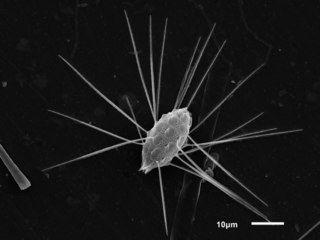
Mallomonas is a genus comprising unicellular algal eukaryotes and characterized by their intricate cell coverings made of silica scales and bristles. The group was first named and classified by Dr. Maximilian Perty in 1852. These organisms live in freshwater and are widely distributed around the world. Some well known species include Mallomonas caudata and Mallomonas splendens.

Synura is a genus of colonial chrysomonad algae covered in silica scales. It is the most conspicuous genus of the order Synurales.
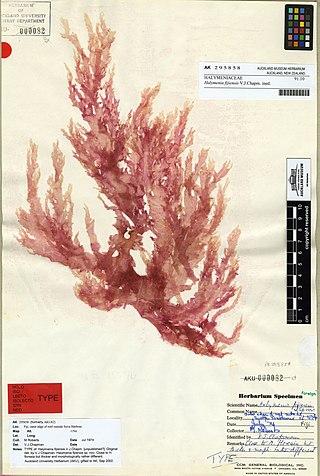
Halymeniales is an order of red algae belonging to the class Florideophyceae and the subclass Rhodymeniophycidae.
Asterochloris is a genus of green algae in the family Trebouxiophyceae. It is a common photobiont in lichen, occurring in the thalli of more than 20 lichen genera worldwide. Asterochloris is distinguishable from the morphologically similar genus Trebouxia, primarily due to its deeply lobed chloroplast, the placement of the chloroplast along the cell's periphery before the initiation of zoospore or aplanospore formation, and its tendency to primarily reproduce asexually through the production of aplanospores.
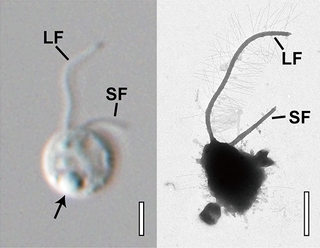
Ochromonadales is an order of single-celled algae belonging to the class Chrysophyceae, also known as golden algae. Initially it contained numerous groups of flagellates that were not closely related. During the late 20th century, advancements in molecular and ultrastructural studies allowed the transfer of many of these groups out of Ochromonadales, and the order was reduced to a single family Ochromonadaceae. They are aquatic single-celled flagellated algae, with two heterokont flagella each, some of which have secondarily lost their chloroplasts and appear colorless.











